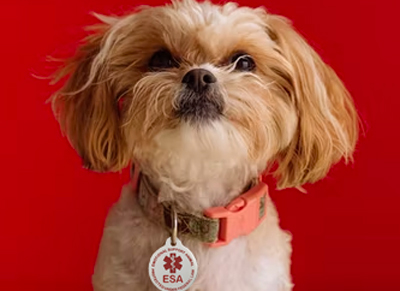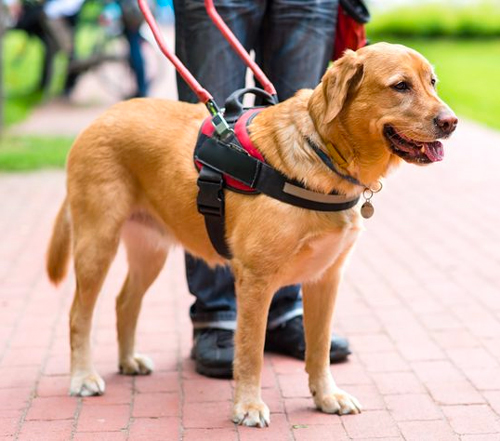-
- SHOP
- Pool Ramp for Dogs
- For People
- For Pets
- Gallery
- Blog
- Our Company
- Cart
- Login
- Newsletter
- Free US Shipping on orders over $79!
At PetStep, we strive to create accessibility solutions for dogs of all sizes, breeds, and abilities. Among those dogs are emotional support animals and service dogs. We want to make sure the pets that improve our way of life are also living their best lives as well.
So, what is the difference between emotional support animals and service dogs? The fact of it is that service dogs are providing a service that helps someone with a disability while emotional support animals are offering a source of comfort.
When looking at the specific reference, the ADA specifies mental illness as an impairment. As the leading reason people have emotional support animals, they do not qualify as a service animal. Service animals are specifically trained to react in a way that supports someone with a physical disability or health condition that could manifest itself in a physical way, possibly causing the owner harm. This training and the diagnosed disability are the separation between the two.
Emotional support animals, or ESAs, fall under the same category of something like a therapy dog. They are trained to offer comfort. This training, more thorough for therapy animals, is simply to be calm in a moment with their person. When registering your pet as an ESA it is on the owner to train the pet to be in public situations, while a service animal goes through rigorous training to perform its duties.

The most popular pets for emotional support animals are cats and dogs, but can also include:
In reality, most any pet can be registered as an ESA. Though some more exotic pets may have more restrictions on where they are allowed, and/or will not be allowed to fly. When choosing your emotional support animal, pick one that brings you the most comfort and fits your lifestyle!
Having an emotional support animal comes with some very nice perks. These include:
Registering your ESA or obtaining a doctor’s note may be necessary to use these benefits. Make sure to go through the US Service Animals website for further information.
“I always rest my head on my human’s lap when I notice they’re sad. I think that makes me an emotional support animal, too, right?”

Service dogs are highly trained “pets” that are always on the job. They can be recognized by their vests that are worn in public indicating they are working and should not be interacted with or distracted. Occasionally you may encounter a service dog when they are without their vest and in those moments they are another furry friend to love! But always ask the owner first, it is polite and they are still dogs.
Currently dogs and miniature horses are the only animals in the US that can be trained as a service animal. They work through learning when to alert their human of a symptom or reaction coming on. They are also trained to provide comfort during the reaction and they are able to get help when necessary.
Under the service dog category are leading dogs. Such as those helping people with blindness and hearing disabilities. These dogs will also be “dressed” for their jobs. Training is extensive and often starts from puppyhood to engrain their tasks to them. These dogs are able to travel with their humans everywhere they go with little to no restriction. The separation of service dogs and ESAs is the amount of training and the overall importance of their duties. Service dogs are our very own everyday superheroes.

According to US Service Animals, the “standard is 120 hours of training for over six months. Again there are no official rules, but it is wise to follow this protocol. The three main areas of training are heeling, proofing, and tasking.” Training can cost upwards of $1,500 and is often not just for your dog but also for you. Learning to properly command and respond to your service dog is important to create the safest situations for everyone.
This is something most people are familiar with training. Heeling your dog refers to calling them back to your heel with their attention on you, awaiting their next command. This training is also used to keep your dog close to you in order to make it easier for them to detect any oncoming issues as well as keep away distractions.
Proofing refers to preparing your dog to ignore distractions. This is important to keep your dog focused on its task and keeping both of you safe. This training ensures your dog is able to perform in any and all situations. It may seem like a dog is well trained at home, but when brought into new environments they may not understand their training continues. Proofing is what solidifies your service dogs training to always be ready to assist you no matter what is happening around them.
Retrieving things you need is a large portion of many service dogs training. Be it an object or a person when help is needed. Tasking also refers to the alerting portion of the training. This is going to be the main function of your service dog’s job. The tasks a service pet is given is likely to differ depending on the help their owner needs. This can be guiding tasks often used by seeing eye dogs or retrieving objects such as medication or things outside of the owner’s range of mobility.
Examples of other tasking trainings:
Following this training, comes registration and the Public Access Test. These credentials are useful when traveling and needing proof of. Service training. Not often required but better safe than sorry. Registration is the closest thing to official licensing currently offered for service dogs.
It is not a stretch to say that our pets save our lives, as I’m sure many would agree. Be it our sweet friends that are there for us day in and day out or our pets that work a little harder to keep us going, like ESAs or service dogs. Following proper training techniques and creating the boundaries of work and home are important for both you and your support animal. Letting you both relax at home even if your pet is still working with and for you there, you both benefit from having time to snuggle and love outside of the stress of everyday life.